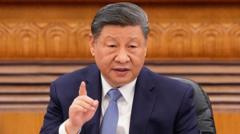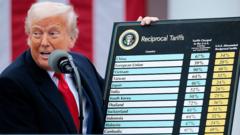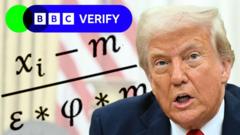**As the US imposes tariffs on a vast array of imports from China and its neighbors, experts predict escalating trade tensions and significant economic repercussions for all parties involved.**
**Tariff Wars: Trump's New Strategy Targeting China and Southeast Asia**

**Tariff Wars: Trump's New Strategy Targeting China and Southeast Asia**
**US President Trump's latest tariffs create a ripple effect across Asia, raising tensions and prompting a swift response from China.**
As President Donald Trump rolls out new tariffs on a wide range of imports, he did not hold back in his criticism of China, calling their trade practices a "full-frontal assault" on American interests. In a statement made during an extensive address, he stressed, "China has taken tremendous advantage of us," citing substantial tariff barriers they impose. Trump’s proposed 34% tariff would be a reciprocal deduction from the current 67% tariffs enforced on US goods by China, aimed at leveling the playing field.
In an immediate reaction, China's Commerce Ministry denounced the strategy as "unilateral bullying," pledging to take “resolute countermeasures” to safeguard its economic interests. The state-run Xinhua news agency condemned Trump for trivializing complex global trade dynamics.
This new wave of tariffs, which comes on the heels of an already imposed 20% on Chinese goods, threatens to increase to 54% in less than a week. In the wake of these policies, the situation for neighboring Southeast Asian nations appears precarious, with heavy tariffs on imports from countries like Vietnam, Laos, and Cambodia making them collateral damage in this trade war.
Experts indicate that Trump’s tariffs not only target China but also effectively encircle its supply chain dependencies. Stephen Innes from SPI Asset Management described the tariffs as a strategic containment measure. Deborah Elms from the Hinrich Foundation echoed this sentiment, suggesting China has little choice but to retaliate.
Vietnam, which has become a key player for businesses looking to evade prior tariffs imposed by the US on China, now finds itself vulnerable with new tariffs ranging from 46% to 49%. The interconnectedness of these economies means that as China seeks alliances in the region and pivots to bolster domestic demand, US companies headquartered in Southeast Asia—such as Apple and Nike—also risk substantial layoffs as their operating costs rise.
Looking ahead, China is poised to respond with its own tariffs and measures targeting US companies, all while contending with internal economic pressures. Analysts predict that while alliances might solidify among affected Asian nations, the immediate future will be marked by escalating trade tensions. Ultimately, experts foresee a return to the negotiating table, although consensus may be a distant goal in the current political climate.




















